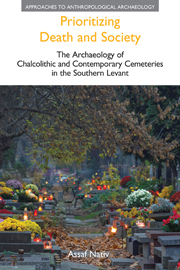 Prioritizing Death and Society
Prioritizing Death and Society Book contents
- Frontmatter
- Dedication
- Contents
- List of figures
- List of tables
- Acknowledgements
- Part I Introduction
- Part II Chalcolithic cemeteries
- 3 Chalcolithic cemeteries: winks, twitches and faked twitches
- 4 Isolated in the landscape: single-cave cemeteries
- 5 Multiple components: multiple-cave cemeteries
- 6 Dark, damp and deep: karstic-cave systems
- 7 Funerary structures
- 8 Exceptions, outliers and misfits
- 9 Structured deposition and depositional structures
- Part III Contemporary cemeteries
- Part IV Conclusion
- Appendix: Gazetteers of cemeteries
- Notes
- Bibliography
- Index
3 - Chalcolithic cemeteries: winks, twitches and faked twitches
from Part II - Chalcolithic cemeteries
- Frontmatter
- Dedication
- Contents
- List of figures
- List of tables
- Acknowledgements
- Part I Introduction
- Part II Chalcolithic cemeteries
- 3 Chalcolithic cemeteries: winks, twitches and faked twitches
- 4 Isolated in the landscape: single-cave cemeteries
- 5 Multiple components: multiple-cave cemeteries
- 6 Dark, damp and deep: karstic-cave systems
- 7 Funerary structures
- 8 Exceptions, outliers and misfits
- 9 Structured deposition and depositional structures
- Part III Contemporary cemeteries
- Part IV Conclusion
- Appendix: Gazetteers of cemeteries
- Notes
- Bibliography
- Index
Summary
As noted, cemeteries are often considered an innovation of the Chalcolithic period. Their novelty, however, does not pertain to the emergence of collective burial grounds per se, but to their specialization. Indeed, sites of repeated human burial are known from earlier periods, particularly the Natufian (e.g. Grosman et al. 2008; Nadel et al. 2009), and the Neolithic (e.g. Galili et al. 2009). However, their funerary function was commonly intertwined with quotidian and sometimes also cultic realms of conduct (cf. Grosman & Munro 2007; Rosen et al. 2007). Unlike these, the cemeteries of the Chalcolithic period suggest a greater degree of specialization: they are clearly demarcated in space, they are only minimally influenced by other fields of practice, and they are specifically designated for the interment of human remains.
Cemeteries, however, are but one aspect of a wide and diverse range of Chalcolithic funerary phenomena, both intra- and extra-mural. Consequently, the line of distinction between cemetery and non-cemetery is not always clear. For this purpose, two strict criteria are upheld in this study: first, the sites in question must be spatially and functionally distinct from habitation sites; and, second, there must be evidence for systematic and repeated interment of human remains. Thus, intra-mural mortuary contexts will not be considered here.
- Type
- Chapter
- Information
- Prioritizing Death and SocietyThe Archaeology of Chalcolithic and Contemporary Cemeteries in the Southern Levant, pp. 25 - 35Publisher: Acumen PublishingPrint publication year: 2013


